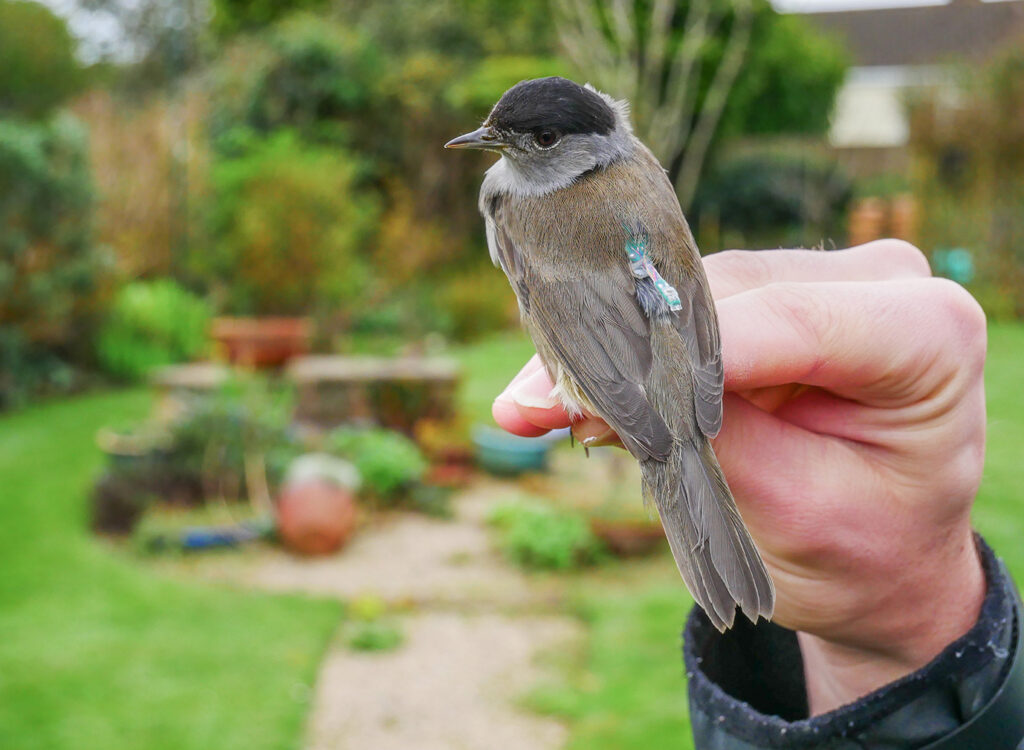The use of bird feeders in the British Isles (the UK and Ireland) has long been a popular pastime. Evidence shows it may also be responsible for large-scale shifts in migratory behavior of some species. For example, the Eurasian Blackcap (Sylvia atricapilla) used to be a scarce wintering bird in the UK and Ireland, but the occurrence of overwintering Blackcaps has increased along with the popularity of bird feeding.
Surprisingly, however, the warblers that overwinter in the British Isles are not the “local” variety; they originate from central Europe (Delmore et al. 2020). Instead of making a traditional southward migration to the Mediterranean region from their breeding grounds in Germany and central Europe, these warblers developed a new migration route to Great Britain and Ireland, where they spend the winter. Here, the presence of artificial feeding stations allows them to more reliably survive the winter (Berthold et al. 1992).
Van Doren et al. (2021) studied the ecology and ecomorphology of these blackcaps in greater detail. Over several winters from November to April, they color-ringed 623 wintering blackcaps at 59 localities, compiling a total of 9,929 observations. The authors and volunteer observers made regular observations of individuals attending garden feeding stations throughout the winter. They also marked 25 birds with geolocators to track their migrations.

Their results revealed that the central European blackcaps migrating to the British Isles showed increased site fidelity to these new wintering grounds. Moreover, adult birds that frequented gardens had better body condition and used the gardens more often during cold and wet conditions. Homeowners tend to provide fatty food in their gardens (like sunflower seeds), which is particularly useful when birds have increased thermoregulatory requirements. This suggests that Eurasian Blackcaps use feeding stations to endure difficult weather conditions enhance their condition.
These findings contrast with the behavior shown by the northern European blackcaps wintering in the Mediterranean region, where they track ephemeral fruit resources and are forced to move once they are depleted. In Britain and Ireland, a highly reliable winter food supply may improve survival by acting as a buffer against harsh weather. Added to this, the predictability of the food resources in home gardens probably contributed to higher site fidelity between winters.
Blackcaps tracked with geolocators arrived at their central European breeding grounds on average just 5.4 days after last being seen in British gardens, suggesting that conditions at these gardens influence body condition on arrival at their breeding spots. It is plausible that the availability of reliable supplemental food gives British and Irish wintering birds an advantage on their central European breeding grounds.
Morphological advantages were also noted in this study. Adults with longer bills and rounder wingtips were more likely to occur at gardens in Britain and Ireland. However, birds wintering in the Mediterranean region needed to feed on a more specialized, frugivorous diet, with more robust food items, like olives (Olea europaea). Those birds migrating to Iberia thus have adapted to consume different types of food items. Similarly, Great Tits (Parus major) in Britain have evolved longer bills in association with supplementary feeding (Bosse et al. 2017). The results by Van Doren et al. (2021) provide additional evidence that supplementary feeding is driving morphological evolution in bird populations.
The Eurasian Blackcap is changing its behavior, morphology, and migration habits in response to human-driven food availability—yet another example of how human activity can induce rapid microevolutionary change in birds.
References
Berthold, P., A.J. Helbig, G. Mohr, and U. Querner (1992). Rapid microevolution of migratory behaviour in a wild bird species. Nature 360(6405): 668–670.
https://doi.org/10.1038/360668a0
Bosse, M., L.G. Spurgin, V.N. Laine,, E.F. Cole, J.A. Firth, P. Gienapp, A.G. Gosler, K. McMahon, J. Poissant, I. Verhagen, M.A.M. Groenen, K. van Oers, B.C. Sheldon, M.E. Visser, and J. Slate (2017). Recent natural selection causes adaptive evolution of an avian polygenic trait. Science 358(6361): 365–368.
https://doi.org/10.1126/ science.aal3298
Delmore, K.E., B.M. Van Doren, G.J. Conway, T. Curk, T. Garrido-Garduño, R.R. Germain, T. Hasselmann, D. Hiemer, H.P. van der Jeugd, H. Justen, J.S. Lugo Ramos, I. Maggini, B.S. Meyer, R.J. Phillips, M. Remisiewicz, G.C.M. Roberts, B.C. Sheldon, W. Vogl, and M. Liedvogel (2020). Individual variability and versatility in an eco-evolutionary model of avian migration. Proceedings of the Royal Society B 287: 20201339.
http://doi.org/10.1098/rspb.2020.1339
Van Doren, B.M., G.J. Conway, R.J. Phillips, G.C. Evans, G.C.M. Roberts, M. Liedvogel, and B.C. Sheldon (in press). Human activity shapes the wintering ecology of a migratory bird. Global Change Biology.

Partnerships
A global alliance of nature organizations working to document the natural history of all bird species at an unprecedented scale.

















